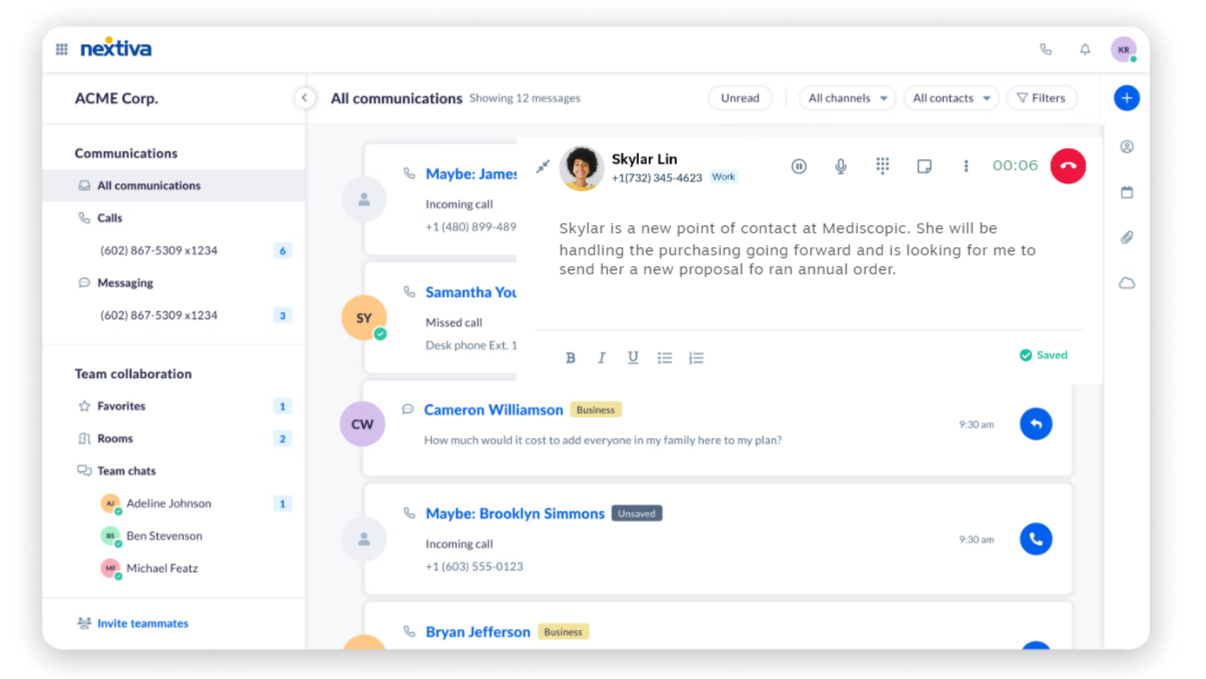
Softphone functionality allows tablets, laptops, and mobile devices to make and receive calls as if they were a traditional desk phone. It’s a VoIP option that lets people use devices they already own to handle calls from anywhere with an internet connection.
This offers quite a few distinct advantages for a company, especially when integrated with other business tools to create a unified communications platform.
When optimally implemented, businesses can use softphones to add contacts from other apps, automate tasks, generate follow-ups, improve workflows, handle seasonal fluctuations, and scale up or down as needed.
Almost any device can be adapted into a softphone, though older devices may experience performance issues. It’s best to check system requirements for hardware and connection before committing to a softphone rollout.
Once you know you have compatible equipment, all you need is an internet connection, a VoIP subscription, and the service provider’s app installed on your device. Check out our list of the best VoIP phone services to learn about all of your options and what to look for when making your decision.
All that’s left after that is downloading the app, launching it, and signing in. Some services may require you to verify your phone number with a code, while other services only require email verification.
Most VoIP providers will walk you through quick configuration settings before making your first call. You’ll be able to adjust audio and video settings, set up notification preferences, and familiarize yourself with the interface.

Softphones and Wi-Fi calling both use the internet to facilitate calls, but they’re not the same.
Wi-Fi calling is available through some mobile carriers, like Verizon and TMobile. It allows you to handle regular phone calls using Wi-Fi if your 4G or 5G connection isn’t strong enough.
I inadvertently end up using this all the time since cell phone service is spotty where I live. It ensures smooth call quality by seamlessly switching between Wi-Fi and my cellular network as needed.
A softphone, although similar, requires a VoIP subscription.
Softphones need some form of internet connectivity–it doesn’t have to be Wi-Fi. VoIP can run off of a Wi-Fi connection, ethernet connection, or cellular network. You can also use softphones on a tablet or desktop, where Wi-Fi calling is limited to your cell phone.
Unlike traditional desk phones, softphones make it easy to connect with the other business tools your team uses every day. When all your software is seamlessly integrated, employees don’t have to switch between systems to find what they need.
Softphones can pull information from CRM software, collaboration tools, email clients, customer service software, and more.
All that information and much-needed context will then be easily accessible from the same interface. When an agent gets a call, for example, they can quickly see who the caller is, what their previous purchases were, and the transcript of their last interaction.
They won’t have to go into the interaction cold, which creates a much better user and customer experience.

Businesses will also benefit from a wide range of other VoIP features with their subscription, including:
A softphone can provide you with a full–fledged phone system that includes all the tools businesses need.
Administrators can manage user settings, permissions, and softphone configurations from a centralized interface. This means they can remotely update software, help users resolve issues, and make quick adjustments without the user waiting around or pausing their work.
Adding new users to a softphone system requires just a few clicks. And unlike physical hardware, softphone systems can also be maintained and upgraded without the need for on-site technicians.
Yes, for a lot of reasons. First and foremost, VoIP subscriptions tend to cost significantly less than traditional landline or on-premise systems. VoIP also offers lower international calling rates, making it an attractive option for businesses that regularly handle calls around the world.
A VoIP system and softphone functionality also means you won’t need to buy physical phones. Outdated hardware and miles of phone wiring are a thing of the past. Beyond that, you won’t have to worry about infrastructure maintenance as it’s handled by your VoIP provider.
Softphones have a lot of good things going for them, but they aren’t without their faults.
Softphones are only as reliable as your internet connection. You don’t need the world’s fastest network, but it has to be stable enough to send, receive, and unpack data packets.
Just like with a spotty cellular network, poor internet connection can result in dropped calls, severe delays, and even echoing.
Network congestion can also affect call quality, especially for larger businesses. Concurrent calls, browsing the internet, streaming a video, sending an email, or downloading a large file can all impact your network.
You can tweak Quality of Service (QoS) settings to prioritize VoIP traffic as a starting point. This means the network will pause other activities if needed in order to preserve call quality. That can be frustrating for those users who have to wait, but it’s a small price to pay for a consistent customer experience.
If adjusting QoS settings doesn’t help, you may need a separate network specifically for your phone system. While this ensures high-quality calls, it can get expensive.
Softphone systems integrate well with modern business apps, but companies with complex or customized legacy systems may need help.
Integrating with a bespoke CRM you built or a proprietary comms system, for example, may require a developer or be impossible. If you don’t have someone on your team who knows their way around APIs and code, connecting tools could be more challenging than you anticipated.
Some businesses are required to use traditional phone systems because of legal regulations.
For example, the U.S. healthcare and finance sectors must meet specific communications and data security criteria. For many, a traditional system may be the only way to guarantee compliance.